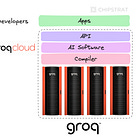Monopsony and TSMC
Monopsony and Oligopsony, Bilateral Monopsony, Market Correlation, Bullwhip Effect, and more
Recently, we explored Groq’s Business Model:
Now, let’s shift gears and explore the implications of TSMC’s increasingly monopsonistic power in the Wafer Fab Equipment (WFE) market.
Monopsony and Oligopsony
From Bloomberg,
ASML cut its outlook for next year, triggering a 16% decline in its share price on Tuesday in Amsterdam, the biggest since June 12, 1998.
ASML is facing pressure from multiple directions. While demand for the chips that power AI data centers remains strong, key customers including Intel Corp. and Samsung are struggling.
Intel, faced with shrinking sales and mounting losses, last month delayed new factories planned in Germany and Poland. Samsung issued an apology to investors this month for disappointing results after delays let competitors dominate the market for high-bandwidth memory chips used in AI.
ASML provides its lithography tools to leading-edge logic and memory foundries, such as TSMC, Samsung, Intel Foundry, SK Hynix, and Micron. However, the recent challenges faced by Intel and Samsung have shown that, at times, TSMC is virtually the sole buyer of ASML’s EUV tools in the logic chip sector.
A market dominated by a single buyer is referred to as a monopsony.
For example, the Department of Defense is the only buyer of defense technologies like American fighter jets, nuclear submarines, and missiles. From an educational 1973 publication called Monopsony: A Fundamental Problem in Government Procurement:
Monopsony refers to a market in which there is only a single buyer, i.e., producers cannot find alternative buyers of their product.
Monopsony permits the buyer to establish prices, terms and conditions that are quite different from those that would result from a market structure in which there were many competing buyers and sellers.”
The paper illustrated how the buyer can force prices to unreasonably low levels in the short term, even below the seller's costs, so long as there are multiple sellers and excess capacity in the market.
When there are only a few buyers, it’s an oligopsony. Given the consolidated nature of the semiconductor industry, most markets within the semiconductor supply chain are already oligopsonistic. When Intel and Samsung delay their WFE purchasing, markets feel increasingly monopsonistic.
As an aside, the term monopsony was historically used by economists to describe labor markets with only a single buyer of that labor. Relatedly, the labor market for WFE specialists is also increasingly monopsonistic; if you’re a scientist or engineer with extreme ultraviolet lithography expertise, there are increasingly few employers who will buy your expertise.
Price Negotiations
What does it mean if TSMC is increasingly monopsonistic in the WFE market? TSMC will have greater leverage when negotiating prices with suppliers.
Remember this from last May?
TSMC Says ASML’s Most-Advanced Chip Machines Are Too Expensive:
ASML Holding NV’s new advanced chip machines have a daunting price tag, according to Taiwan Semiconductor Manufacturing Co., one of the Dutch company’s biggest clients.
“The cost is very high,” TSMC Senior Vice President Kevin Zhang said at a technology symposium in Amsterdam on Tuesday, referring to ASML’s latest system known as high-NA extreme ultraviolet. “I like the high-NA EUV’s capability, but I don’t like the sticker price.”
How’s that for a public price negotiation from a buyer with increasingly monopsonistic power?
TSMC’s near-monopsony could also incentivize suppliers to prioritize TSMC's requirements over other customers, potentially impacting Intel and Samsung’s ability to keep up with TSMC’s leading-edge logic capabilities.
Bilateral Monopoly
Most WFE markets are oligopolistic, and some, like EUV, are monopolistic. When there’s only a single seller and a single buyer, we call it a bilateral monopoly. From the earlier 1973 Monopsony paper:
An extreme case is one in which there is only a single buyer and a single seller in a given market, a situation referred to as bilateral monopoly. This situation is rarely encountered in the real world, however, because the existence of substitute products weakens the position of the "single" seller.
The consolidated semiconductor market has the characteristics for bilateral monopolies to emerge. For example, it’s truly possible for no substitute product to exist. The textbook example is, of course, EUV. In the case of leading-edge logic chips, there isn’t a practical alternative to EUV. Just ask Intel.
Intel — We will not need EUV for 10nm process technology:
“We know we can get through 10nm without EUV,” said Brian Krzanich, chief executive officer of Intel at the Citi Global Technology Conference.
In hindsight, that wasn’t true. Intel got stuck at 10nm while TSMC flew right by on its way to an earned monopsony.
The game theory that emerges from bilateral monopolies is quite interesting to ponder. Consider ASML’s negotiations with TSMC. Do either even have BATNAs?
Not a Pure Monopsony
Of course, TSMC isn’t a pure monopsony in the WFE market. Intel and Samsung are still buying tools, just not as often as WFE manufacturers would like. Memory manufacturers also buy WFE tools, and trailing-edge foundries do too.
However, buyer power is increasingly shifting to Asia; China is investing heavily in mature nodes, and TSMC is increasingly dominating leading-edge purchasing.
Given TSMC’s proximity to China, the US is trying to beef up leading-edge capacity on American soil to reduce risk, which would also shift WFE purchasing power back to the United States.
Except TSMC might win that race too. From Bloomberg,
Taiwan Semiconductor Manufacturing Co. has achieved early production yields at its first plant in Arizona that surpass similar factories back home, a significant breakthrough for a US expansion project initially dogged by delays and worker strife.
The share of chips manufactured at TSMC’s facility in Phoenix that are usable is about 4 percentage points higher than comparable facilities in Taiwan, Rick Cassidy, president of TSMC’s US division, told listeners on a webinar Wednesday, according to a person who participated. The success rate, or yield, is a critical measure in the semiconductor industry because it determines whether companies will be able to cover the enormous costs of a chip plant.
That’s not a good sign for WFE manufacturer's negotiating power.
Correlation In The Markets
TSMC’s growing monopsonistic influence in the WFE market poses risks of correlated outcomes within the semiconductor industry. Any downturns that cause TSMC to reduce capital expenditures would have an outsized impact on the WFE market. Given the consolidated nature of semis, it would subsequently impact the broader semiconductor market, such as the PHLX. Of course, semis companies impact many top companies in the broader market, so monopsonistic TSMC’s purse-string movements could reverberate far and wide.
Moreover, monopsonistic TSMC’s demand fluctuations could increase the likelihood of a bullwhip effect in the semiconductor supply chain.
Impact on the United States
The CHIPS Act exists to prevent an Asian-Pacific monopoly on leading-edge foundry manufacturing. Less obvious but still important is avoiding an Asian-Pacific monopsony in the wafer fab equipment market. We need more than one buyer, and preferably one on American soil. Intel Foundry needs to deliver 18A and 14A competitively and on time to secure external business and re-emerge as a strong second buyer of WFE.






